Ryanair Customer Satisfaction Report
VerifiedAdded on 2020/01/28
|32
|7087
|284
Report
AI Summary
This report investigates factors influencing customer satisfaction at Ryanair, a low-cost airline. It uses a descriptive survey design, collecting both quantitative and qualitative data from 20 UK Business and Computing College students (10 from Business Management and 10 from Travel and Tourism Management). The study examines the impact of promotion, service quality, brand, and price fairness on customer satisfaction. Findings reveal that promotion significantly affects satisfaction, followed by service quality. Brand impact is moderate, and price fairness also plays a role. The report concludes with recommendations for Ryanair to enhance customer satisfaction by improving promotional strategies, service quality, brand image, and price fairness.
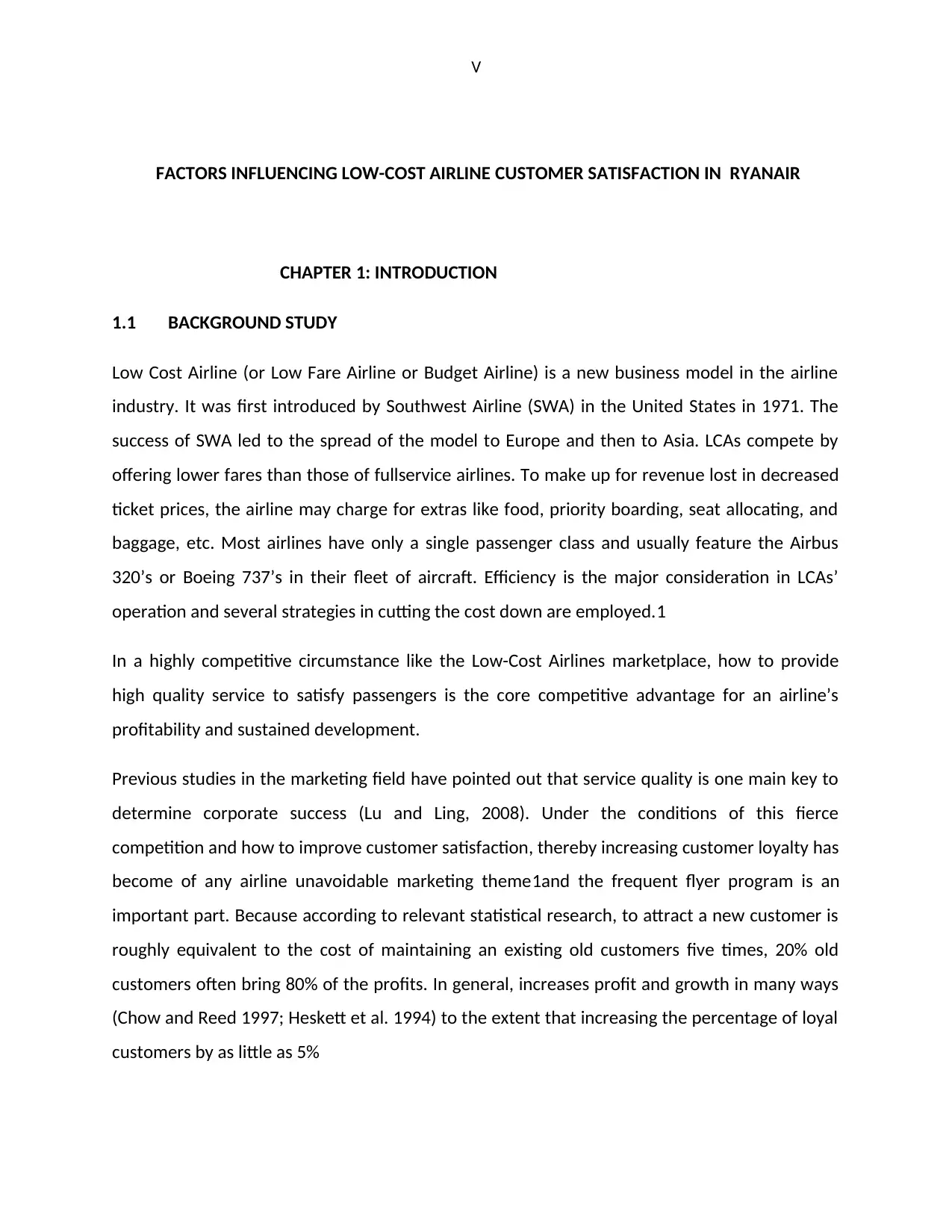
V
FACTORS INFLUENCING LOW-COST AIRLINE CUSTOMER SATISFACTION IN RYANAIR
CHAPTER 1: INTRODUCTION
1.1 BACKGROUND STUDY
Low Cost Airline (or Low Fare Airline or Budget Airline) is a new business model in the airline
industry. It was first introduced by Southwest Airline (SWA) in the United States in 1971. The
success of SWA led to the spread of the model to Europe and then to Asia. LCAs compete by
offering lower fares than those of fullservice airlines. To make up for revenue lost in decreased
ticket prices, the airline may charge for extras like food, priority boarding, seat allocating, and
baggage, etc. Most airlines have only a single passenger class and usually feature the Airbus
320’s or Boeing 737’s in their fleet of aircraft. Efficiency is the major consideration in LCAs’
operation and several strategies in cutting the cost down are employed.1
In a highly competitive circumstance like the Low-Cost Airlines marketplace, how to provide
high quality service to satisfy passengers is the core competitive advantage for an airline’s
profitability and sustained development.
Previous studies in the marketing field have pointed out that service quality is one main key to
determine corporate success (Lu and Ling, 2008). Under the conditions of this fierce
competition and how to improve customer satisfaction, thereby increasing customer loyalty has
become of any airline unavoidable marketing theme1and the frequent flyer program is an
important part. Because according to relevant statistical research, to attract a new customer is
roughly equivalent to the cost of maintaining an existing old customers five times, 20% old
customers often bring 80% of the profits. In general, increases profit and growth in many ways
(Chow and Reed 1997; Heskett et al. 1994) to the extent that increasing the percentage of loyal
customers by as little as 5%
FACTORS INFLUENCING LOW-COST AIRLINE CUSTOMER SATISFACTION IN RYANAIR
CHAPTER 1: INTRODUCTION
1.1 BACKGROUND STUDY
Low Cost Airline (or Low Fare Airline or Budget Airline) is a new business model in the airline
industry. It was first introduced by Southwest Airline (SWA) in the United States in 1971. The
success of SWA led to the spread of the model to Europe and then to Asia. LCAs compete by
offering lower fares than those of fullservice airlines. To make up for revenue lost in decreased
ticket prices, the airline may charge for extras like food, priority boarding, seat allocating, and
baggage, etc. Most airlines have only a single passenger class and usually feature the Airbus
320’s or Boeing 737’s in their fleet of aircraft. Efficiency is the major consideration in LCAs’
operation and several strategies in cutting the cost down are employed.1
In a highly competitive circumstance like the Low-Cost Airlines marketplace, how to provide
high quality service to satisfy passengers is the core competitive advantage for an airline’s
profitability and sustained development.
Previous studies in the marketing field have pointed out that service quality is one main key to
determine corporate success (Lu and Ling, 2008). Under the conditions of this fierce
competition and how to improve customer satisfaction, thereby increasing customer loyalty has
become of any airline unavoidable marketing theme1and the frequent flyer program is an
important part. Because according to relevant statistical research, to attract a new customer is
roughly equivalent to the cost of maintaining an existing old customers five times, 20% old
customers often bring 80% of the profits. In general, increases profit and growth in many ways
(Chow and Reed 1997; Heskett et al. 1994) to the extent that increasing the percentage of loyal
customers by as little as 5%
Paraphrase This Document
Need a fresh take? Get an instant paraphrase of this document with our AI Paraphraser
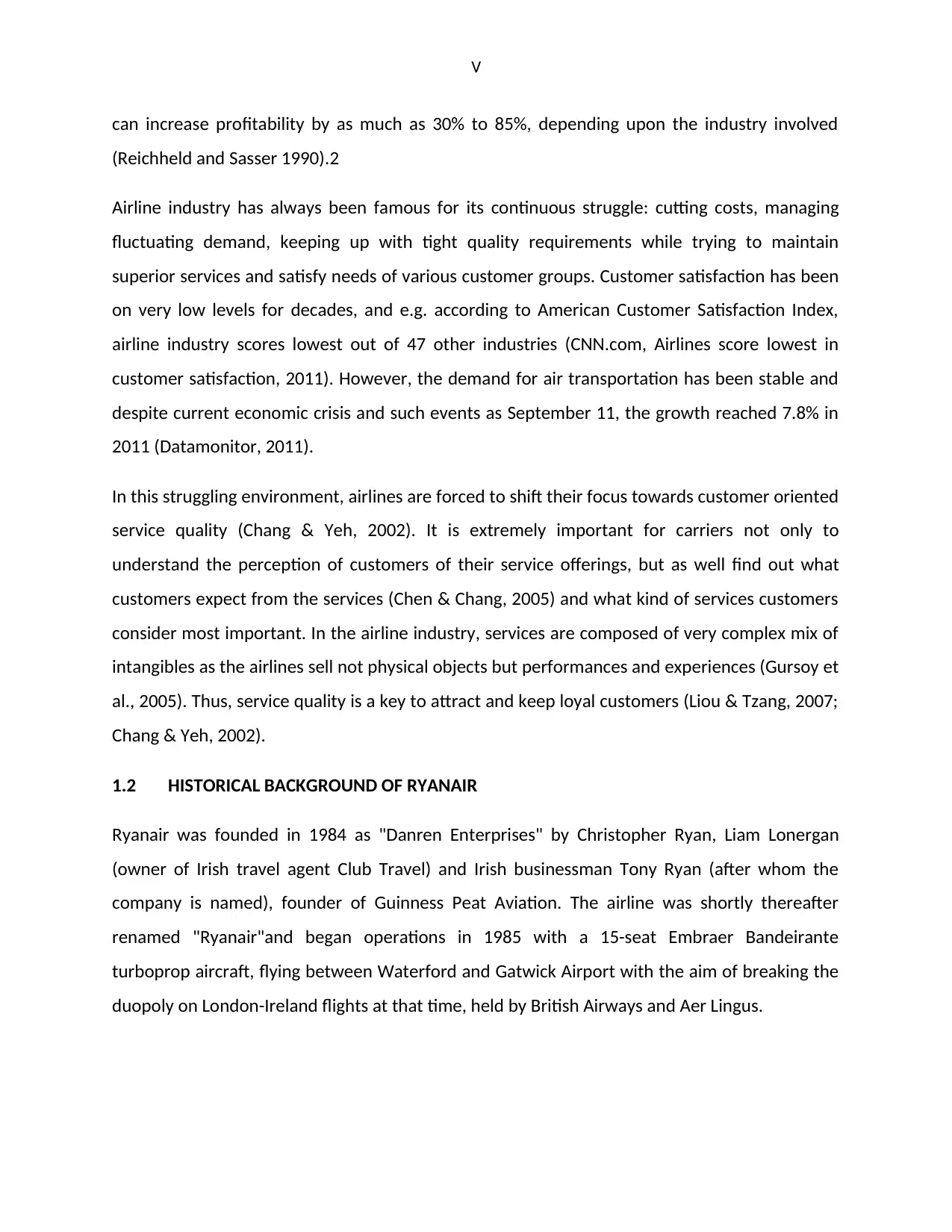
V
can increase profitability by as much as 30% to 85%, depending upon the industry involved
(Reichheld and Sasser 1990).2
Airline industry has always been famous for its continuous struggle: cutting costs, managing
fluctuating demand, keeping up with tight quality requirements while trying to maintain
superior services and satisfy needs of various customer groups. Customer satisfaction has been
on very low levels for decades, and e.g. according to American Customer Satisfaction Index,
airline industry scores lowest out of 47 other industries (CNN.com, Airlines score lowest in
customer satisfaction, 2011). However, the demand for air transportation has been stable and
despite current economic crisis and such events as September 11, the growth reached 7.8% in
2011 (Datamonitor, 2011).
In this struggling environment, airlines are forced to shift their focus towards customer oriented
service quality (Chang & Yeh, 2002). It is extremely important for carriers not only to
understand the perception of customers of their service offerings, but as well find out what
customers expect from the services (Chen & Chang, 2005) and what kind of services customers
consider most important. In the airline industry, services are composed of very complex mix of
intangibles as the airlines sell not physical objects but performances and experiences (Gursoy et
al., 2005). Thus, service quality is a key to attract and keep loyal customers (Liou & Tzang, 2007;
Chang & Yeh, 2002).
1.2 HISTORICAL BACKGROUND OF RYANAIR
Ryanair was founded in 1984 as "Danren Enterprises" by Christopher Ryan, Liam Lonergan
(owner of Irish travel agent Club Travel) and Irish businessman Tony Ryan (after whom the
company is named), founder of Guinness Peat Aviation. The airline was shortly thereafter
renamed "Ryanair"and began operations in 1985 with a 15-seat Embraer Bandeirante
turboprop aircraft, flying between Waterford and Gatwick Airport with the aim of breaking the
duopoly on London-Ireland flights at that time, held by British Airways and Aer Lingus.
can increase profitability by as much as 30% to 85%, depending upon the industry involved
(Reichheld and Sasser 1990).2
Airline industry has always been famous for its continuous struggle: cutting costs, managing
fluctuating demand, keeping up with tight quality requirements while trying to maintain
superior services and satisfy needs of various customer groups. Customer satisfaction has been
on very low levels for decades, and e.g. according to American Customer Satisfaction Index,
airline industry scores lowest out of 47 other industries (CNN.com, Airlines score lowest in
customer satisfaction, 2011). However, the demand for air transportation has been stable and
despite current economic crisis and such events as September 11, the growth reached 7.8% in
2011 (Datamonitor, 2011).
In this struggling environment, airlines are forced to shift their focus towards customer oriented
service quality (Chang & Yeh, 2002). It is extremely important for carriers not only to
understand the perception of customers of their service offerings, but as well find out what
customers expect from the services (Chen & Chang, 2005) and what kind of services customers
consider most important. In the airline industry, services are composed of very complex mix of
intangibles as the airlines sell not physical objects but performances and experiences (Gursoy et
al., 2005). Thus, service quality is a key to attract and keep loyal customers (Liou & Tzang, 2007;
Chang & Yeh, 2002).
1.2 HISTORICAL BACKGROUND OF RYANAIR
Ryanair was founded in 1984 as "Danren Enterprises" by Christopher Ryan, Liam Lonergan
(owner of Irish travel agent Club Travel) and Irish businessman Tony Ryan (after whom the
company is named), founder of Guinness Peat Aviation. The airline was shortly thereafter
renamed "Ryanair"and began operations in 1985 with a 15-seat Embraer Bandeirante
turboprop aircraft, flying between Waterford and Gatwick Airport with the aim of breaking the
duopoly on London-Ireland flights at that time, held by British Airways and Aer Lingus.
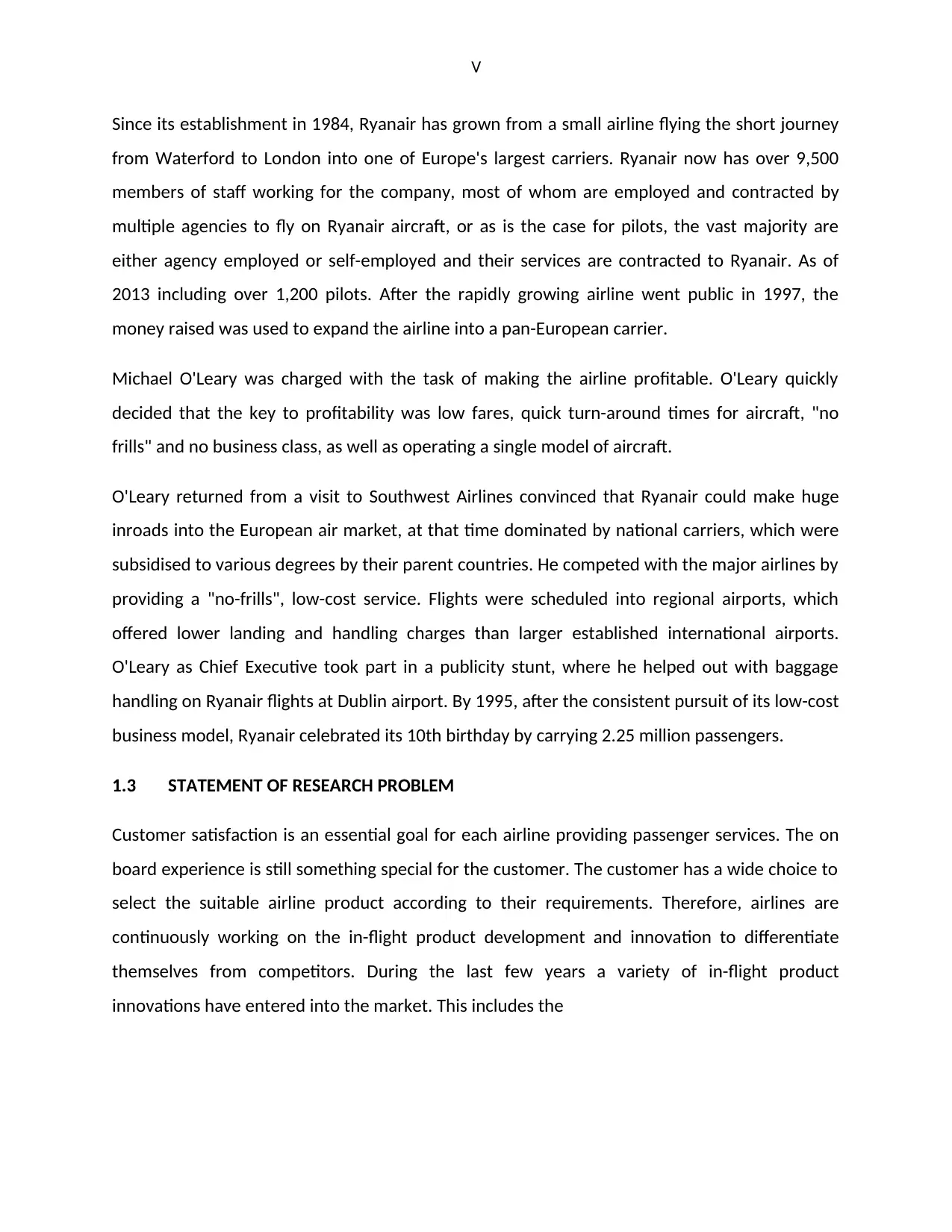
V
Since its establishment in 1984, Ryanair has grown from a small airline flying the short journey
from Waterford to London into one of Europe's largest carriers. Ryanair now has over 9,500
members of staff working for the company, most of whom are employed and contracted by
multiple agencies to fly on Ryanair aircraft, or as is the case for pilots, the vast majority are
either agency employed or self-employed and their services are contracted to Ryanair. As of
2013 including over 1,200 pilots. After the rapidly growing airline went public in 1997, the
money raised was used to expand the airline into a pan-European carrier.
Michael O'Leary was charged with the task of making the airline profitable. O'Leary quickly
decided that the key to profitability was low fares, quick turn-around times for aircraft, "no
frills" and no business class, as well as operating a single model of aircraft.
O'Leary returned from a visit to Southwest Airlines convinced that Ryanair could make huge
inroads into the European air market, at that time dominated by national carriers, which were
subsidised to various degrees by their parent countries. He competed with the major airlines by
providing a "no-frills", low-cost service. Flights were scheduled into regional airports, which
offered lower landing and handling charges than larger established international airports.
O'Leary as Chief Executive took part in a publicity stunt, where he helped out with baggage
handling on Ryanair flights at Dublin airport. By 1995, after the consistent pursuit of its low-cost
business model, Ryanair celebrated its 10th birthday by carrying 2.25 million passengers.
1.3 STATEMENT OF RESEARCH PROBLEM
Customer satisfaction is an essential goal for each airline providing passenger services. The on
board experience is still something special for the customer. The customer has a wide choice to
select the suitable airline product according to their requirements. Therefore, airlines are
continuously working on the in-flight product development and innovation to differentiate
themselves from competitors. During the last few years a variety of in-flight product
innovations have entered into the market. This includes the
Since its establishment in 1984, Ryanair has grown from a small airline flying the short journey
from Waterford to London into one of Europe's largest carriers. Ryanair now has over 9,500
members of staff working for the company, most of whom are employed and contracted by
multiple agencies to fly on Ryanair aircraft, or as is the case for pilots, the vast majority are
either agency employed or self-employed and their services are contracted to Ryanair. As of
2013 including over 1,200 pilots. After the rapidly growing airline went public in 1997, the
money raised was used to expand the airline into a pan-European carrier.
Michael O'Leary was charged with the task of making the airline profitable. O'Leary quickly
decided that the key to profitability was low fares, quick turn-around times for aircraft, "no
frills" and no business class, as well as operating a single model of aircraft.
O'Leary returned from a visit to Southwest Airlines convinced that Ryanair could make huge
inroads into the European air market, at that time dominated by national carriers, which were
subsidised to various degrees by their parent countries. He competed with the major airlines by
providing a "no-frills", low-cost service. Flights were scheduled into regional airports, which
offered lower landing and handling charges than larger established international airports.
O'Leary as Chief Executive took part in a publicity stunt, where he helped out with baggage
handling on Ryanair flights at Dublin airport. By 1995, after the consistent pursuit of its low-cost
business model, Ryanair celebrated its 10th birthday by carrying 2.25 million passengers.
1.3 STATEMENT OF RESEARCH PROBLEM
Customer satisfaction is an essential goal for each airline providing passenger services. The on
board experience is still something special for the customer. The customer has a wide choice to
select the suitable airline product according to their requirements. Therefore, airlines are
continuously working on the in-flight product development and innovation to differentiate
themselves from competitors. During the last few years a variety of in-flight product
innovations have entered into the market. This includes the
⊘ This is a preview!⊘
Do you want full access?
Subscribe today to unlock all pages.

Trusted by 1+ million students worldwide
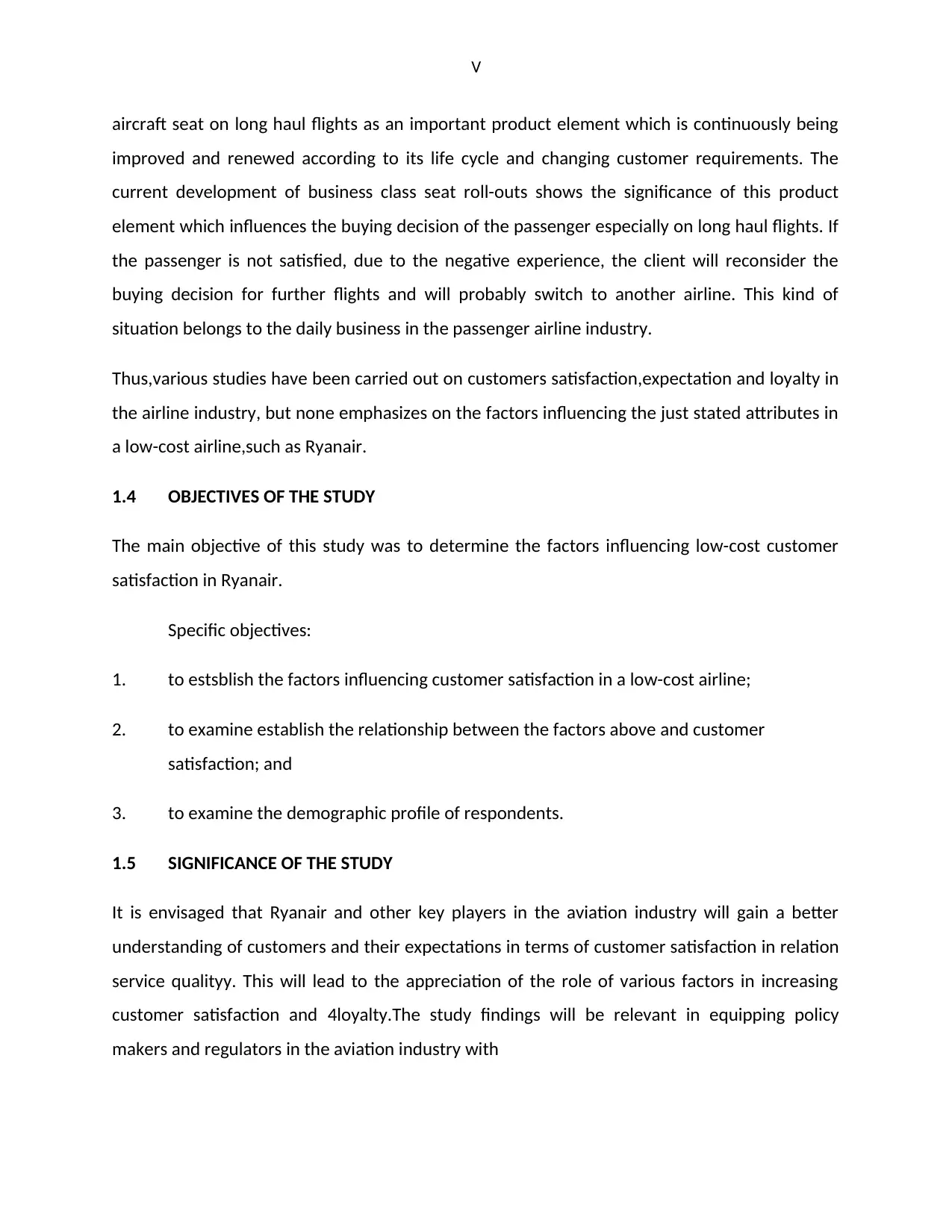
V
aircraft seat on long haul flights as an important product element which is continuously being
improved and renewed according to its life cycle and changing customer requirements. The
current development of business class seat roll-outs shows the significance of this product
element which influences the buying decision of the passenger especially on long haul flights. If
the passenger is not satisfied, due to the negative experience, the client will reconsider the
buying decision for further flights and will probably switch to another airline. This kind of
situation belongs to the daily business in the passenger airline industry.
Thus,various studies have been carried out on customers satisfaction,expectation and loyalty in
the airline industry, but none emphasizes on the factors influencing the just stated attributes in
a low-cost airline,such as Ryanair.
1.4 OBJECTIVES OF THE STUDY
The main objective of this study was to determine the factors influencing low-cost customer
satisfaction in Ryanair.
Specific objectives:
1. to estsblish the factors influencing customer satisfaction in a low-cost airline;
2. to examine establish the relationship between the factors above and customer
satisfaction; and
3. to examine the demographic profile of respondents.
1.5 SIGNIFICANCE OF THE STUDY
It is envisaged that Ryanair and other key players in the aviation industry will gain a better
understanding of customers and their expectations in terms of customer satisfaction in relation
service qualityy. This will lead to the appreciation of the role of various factors in increasing
customer satisfaction and 4loyalty.The study findings will be relevant in equipping policy
makers and regulators in the aviation industry with
aircraft seat on long haul flights as an important product element which is continuously being
improved and renewed according to its life cycle and changing customer requirements. The
current development of business class seat roll-outs shows the significance of this product
element which influences the buying decision of the passenger especially on long haul flights. If
the passenger is not satisfied, due to the negative experience, the client will reconsider the
buying decision for further flights and will probably switch to another airline. This kind of
situation belongs to the daily business in the passenger airline industry.
Thus,various studies have been carried out on customers satisfaction,expectation and loyalty in
the airline industry, but none emphasizes on the factors influencing the just stated attributes in
a low-cost airline,such as Ryanair.
1.4 OBJECTIVES OF THE STUDY
The main objective of this study was to determine the factors influencing low-cost customer
satisfaction in Ryanair.
Specific objectives:
1. to estsblish the factors influencing customer satisfaction in a low-cost airline;
2. to examine establish the relationship between the factors above and customer
satisfaction; and
3. to examine the demographic profile of respondents.
1.5 SIGNIFICANCE OF THE STUDY
It is envisaged that Ryanair and other key players in the aviation industry will gain a better
understanding of customers and their expectations in terms of customer satisfaction in relation
service qualityy. This will lead to the appreciation of the role of various factors in increasing
customer satisfaction and 4loyalty.The study findings will be relevant in equipping policy
makers and regulators in the aviation industry with
Paraphrase This Document
Need a fresh take? Get an instant paraphrase of this document with our AI Paraphraser
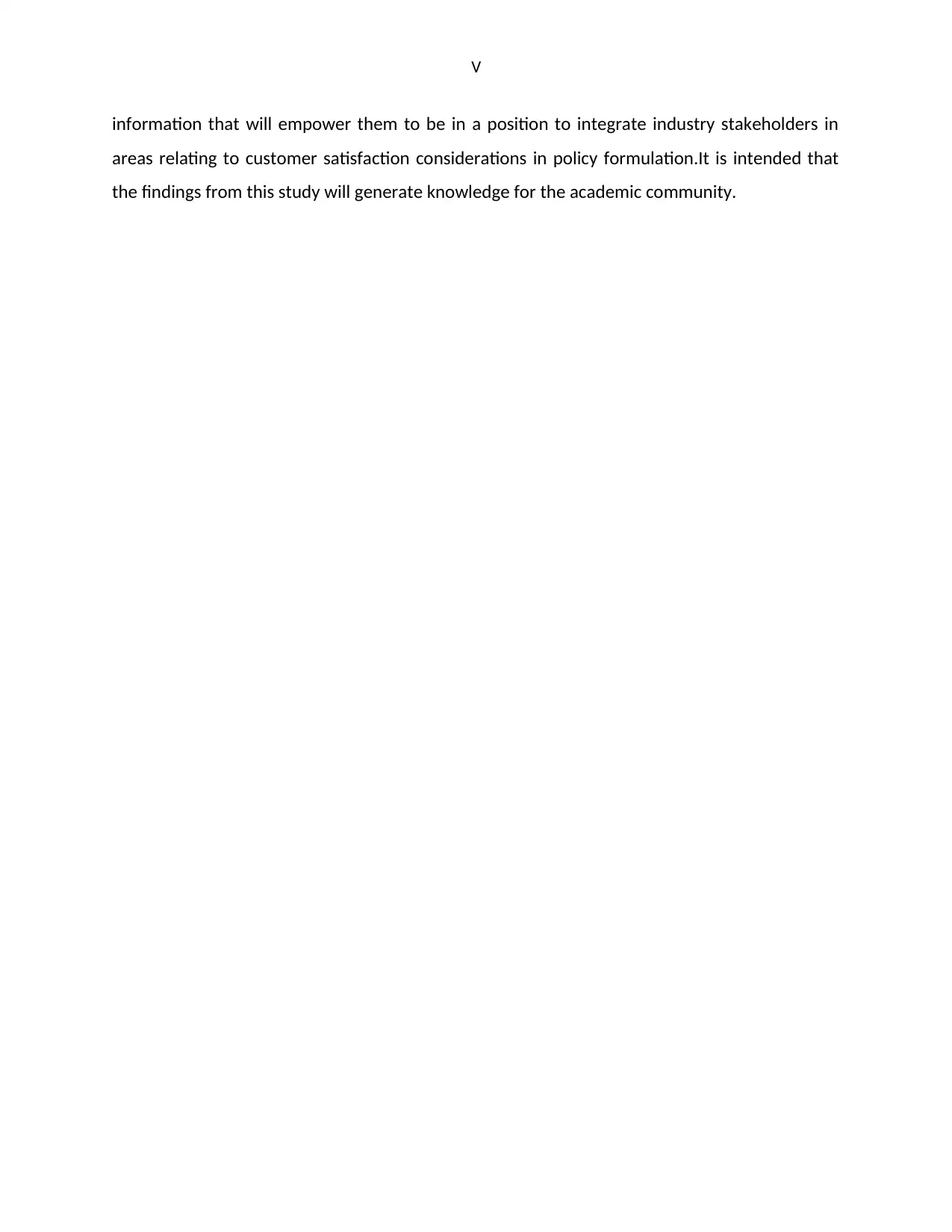
V
information that will empower them to be in a position to integrate industry stakeholders in
areas relating to customer satisfaction considerations in policy formulation.It is intended that
the findings from this study will generate knowledge for the academic community.
information that will empower them to be in a position to integrate industry stakeholders in
areas relating to customer satisfaction considerations in policy formulation.It is intended that
the findings from this study will generate knowledge for the academic community.
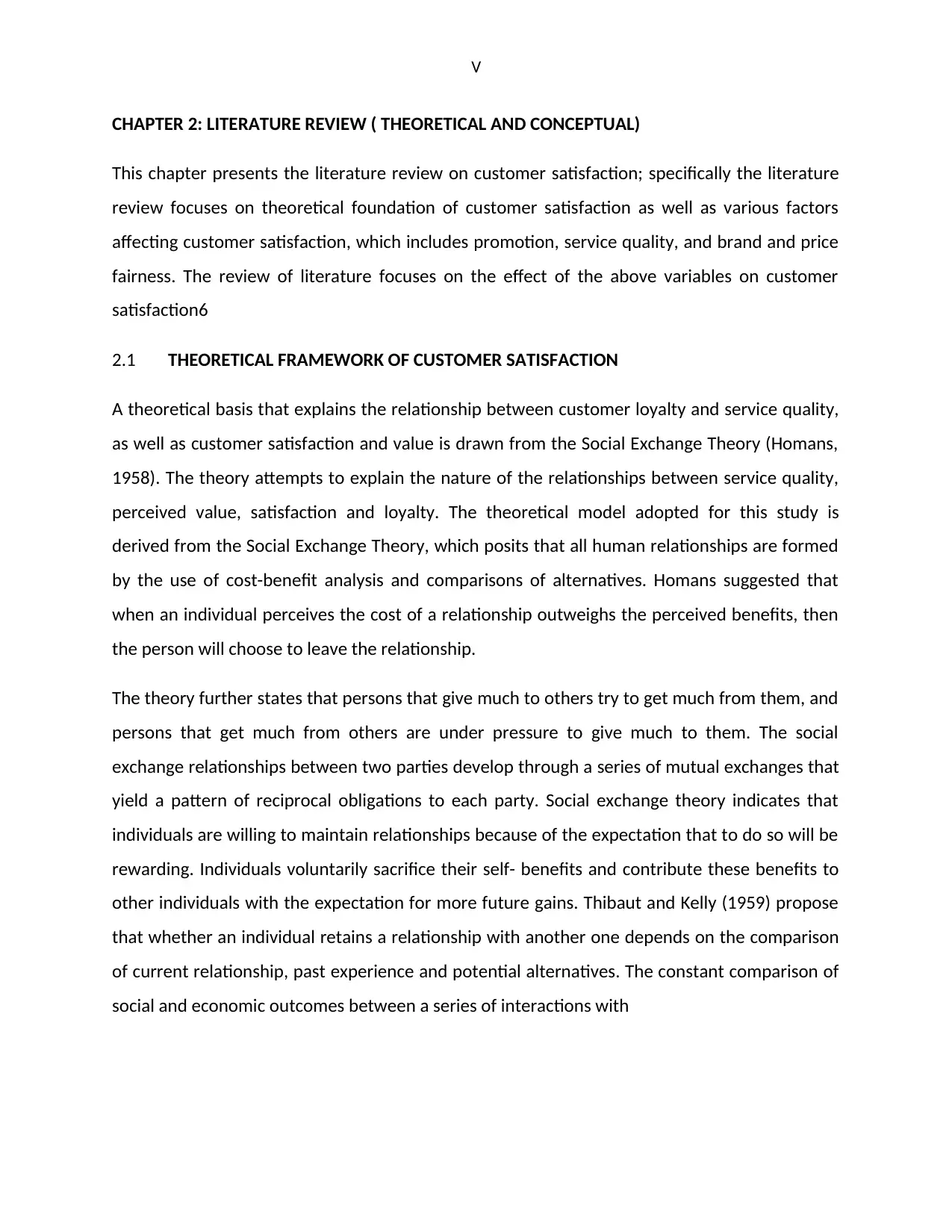
V
CHAPTER 2: LITERATURE REVIEW ( THEORETICAL AND CONCEPTUAL)
This chapter presents the literature review on customer satisfaction; specifically the literature
review focuses on theoretical foundation of customer satisfaction as well as various factors
affecting customer satisfaction, which includes promotion, service quality, and brand and price
fairness. The review of literature focuses on the effect of the above variables on customer
satisfaction6
2.1 THEORETICAL FRAMEWORK OF CUSTOMER SATISFACTION
A theoretical basis that explains the relationship between customer loyalty and service quality,
as well as customer satisfaction and value is drawn from the Social Exchange Theory (Homans,
1958). The theory attempts to explain the nature of the relationships between service quality,
perceived value, satisfaction and loyalty. The theoretical model adopted for this study is
derived from the Social Exchange Theory, which posits that all human relationships are formed
by the use of cost-benefit analysis and comparisons of alternatives. Homans suggested that
when an individual perceives the cost of a relationship outweighs the perceived benefits, then
the person will choose to leave the relationship.
The theory further states that persons that give much to others try to get much from them, and
persons that get much from others are under pressure to give much to them. The social
exchange relationships between two parties develop through a series of mutual exchanges that
yield a pattern of reciprocal obligations to each party. Social exchange theory indicates that
individuals are willing to maintain relationships because of the expectation that to do so will be
rewarding. Individuals voluntarily sacrifice their self- benefits and contribute these benefits to
other individuals with the expectation for more future gains. Thibaut and Kelly (1959) propose
that whether an individual retains a relationship with another one depends on the comparison
of current relationship, past experience and potential alternatives. The constant comparison of
social and economic outcomes between a series of interactions with
CHAPTER 2: LITERATURE REVIEW ( THEORETICAL AND CONCEPTUAL)
This chapter presents the literature review on customer satisfaction; specifically the literature
review focuses on theoretical foundation of customer satisfaction as well as various factors
affecting customer satisfaction, which includes promotion, service quality, and brand and price
fairness. The review of literature focuses on the effect of the above variables on customer
satisfaction6
2.1 THEORETICAL FRAMEWORK OF CUSTOMER SATISFACTION
A theoretical basis that explains the relationship between customer loyalty and service quality,
as well as customer satisfaction and value is drawn from the Social Exchange Theory (Homans,
1958). The theory attempts to explain the nature of the relationships between service quality,
perceived value, satisfaction and loyalty. The theoretical model adopted for this study is
derived from the Social Exchange Theory, which posits that all human relationships are formed
by the use of cost-benefit analysis and comparisons of alternatives. Homans suggested that
when an individual perceives the cost of a relationship outweighs the perceived benefits, then
the person will choose to leave the relationship.
The theory further states that persons that give much to others try to get much from them, and
persons that get much from others are under pressure to give much to them. The social
exchange relationships between two parties develop through a series of mutual exchanges that
yield a pattern of reciprocal obligations to each party. Social exchange theory indicates that
individuals are willing to maintain relationships because of the expectation that to do so will be
rewarding. Individuals voluntarily sacrifice their self- benefits and contribute these benefits to
other individuals with the expectation for more future gains. Thibaut and Kelly (1959) propose
that whether an individual retains a relationship with another one depends on the comparison
of current relationship, past experience and potential alternatives. The constant comparison of
social and economic outcomes between a series of interactions with
⊘ This is a preview!⊘
Do you want full access?
Subscribe today to unlock all pages.

Trusted by 1+ million students worldwide
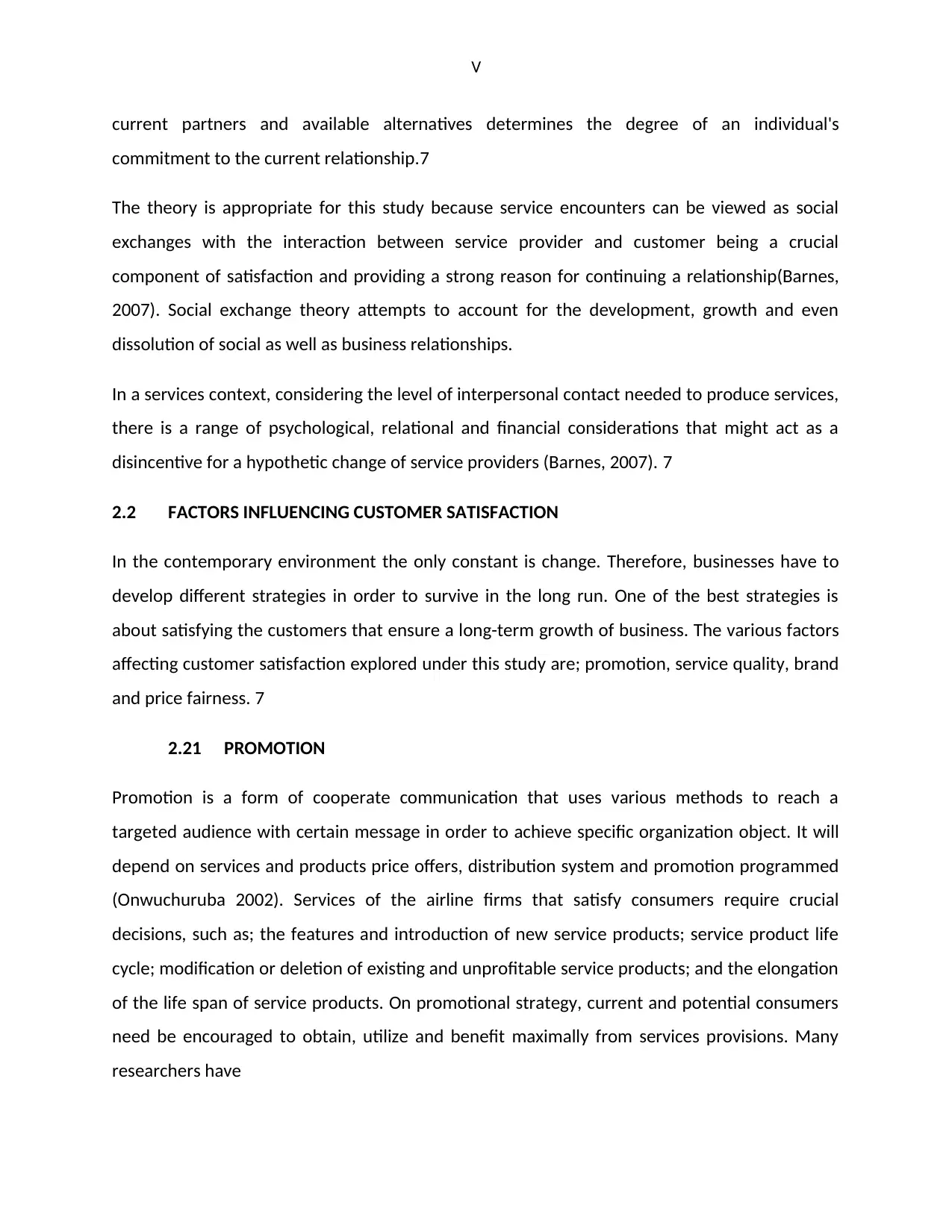
V
current partners and available alternatives determines the degree of an individual's
commitment to the current relationship.7
The theory is appropriate for this study because service encounters can be viewed as social
exchanges with the interaction between service provider and customer being a crucial
component of satisfaction and providing a strong reason for continuing a relationship(Barnes,
2007). Social exchange theory attempts to account for the development, growth and even
dissolution of social as well as business relationships.
In a services context, considering the level of interpersonal contact needed to produce services,
there is a range of psychological, relational and financial considerations that might act as a
disincentive for a hypothetic change of service providers (Barnes, 2007). 7
2.2 FACTORS INFLUENCING CUSTOMER SATISFACTION
In the contemporary environment the only constant is change. Therefore, businesses have to
develop different strategies in order to survive in the long run. One of the best strategies is
about satisfying the customers that ensure a long-term growth of business. The various factors
affecting customer satisfaction explored under this study are; promotion, service quality, brand
and price fairness. 7
2.21 PROMOTION
Promotion is a form of cooperate communication that uses various methods to reach a
targeted audience with certain message in order to achieve specific organization object. It will
depend on services and products price offers, distribution system and promotion programmed
(Onwuchuruba 2002). Services of the airline firms that satisfy consumers require crucial
decisions, such as; the features and introduction of new service products; service product life
cycle; modification or deletion of existing and unprofitable service products; and the elongation
of the life span of service products. On promotional strategy, current and potential consumers
need be encouraged to obtain, utilize and benefit maximally from services provisions. Many
researchers have
current partners and available alternatives determines the degree of an individual's
commitment to the current relationship.7
The theory is appropriate for this study because service encounters can be viewed as social
exchanges with the interaction between service provider and customer being a crucial
component of satisfaction and providing a strong reason for continuing a relationship(Barnes,
2007). Social exchange theory attempts to account for the development, growth and even
dissolution of social as well as business relationships.
In a services context, considering the level of interpersonal contact needed to produce services,
there is a range of psychological, relational and financial considerations that might act as a
disincentive for a hypothetic change of service providers (Barnes, 2007). 7
2.2 FACTORS INFLUENCING CUSTOMER SATISFACTION
In the contemporary environment the only constant is change. Therefore, businesses have to
develop different strategies in order to survive in the long run. One of the best strategies is
about satisfying the customers that ensure a long-term growth of business. The various factors
affecting customer satisfaction explored under this study are; promotion, service quality, brand
and price fairness. 7
2.21 PROMOTION
Promotion is a form of cooperate communication that uses various methods to reach a
targeted audience with certain message in order to achieve specific organization object. It will
depend on services and products price offers, distribution system and promotion programmed
(Onwuchuruba 2002). Services of the airline firms that satisfy consumers require crucial
decisions, such as; the features and introduction of new service products; service product life
cycle; modification or deletion of existing and unprofitable service products; and the elongation
of the life span of service products. On promotional strategy, current and potential consumers
need be encouraged to obtain, utilize and benefit maximally from services provisions. Many
researchers have
Paraphrase This Document
Need a fresh take? Get an instant paraphrase of this document with our AI Paraphraser
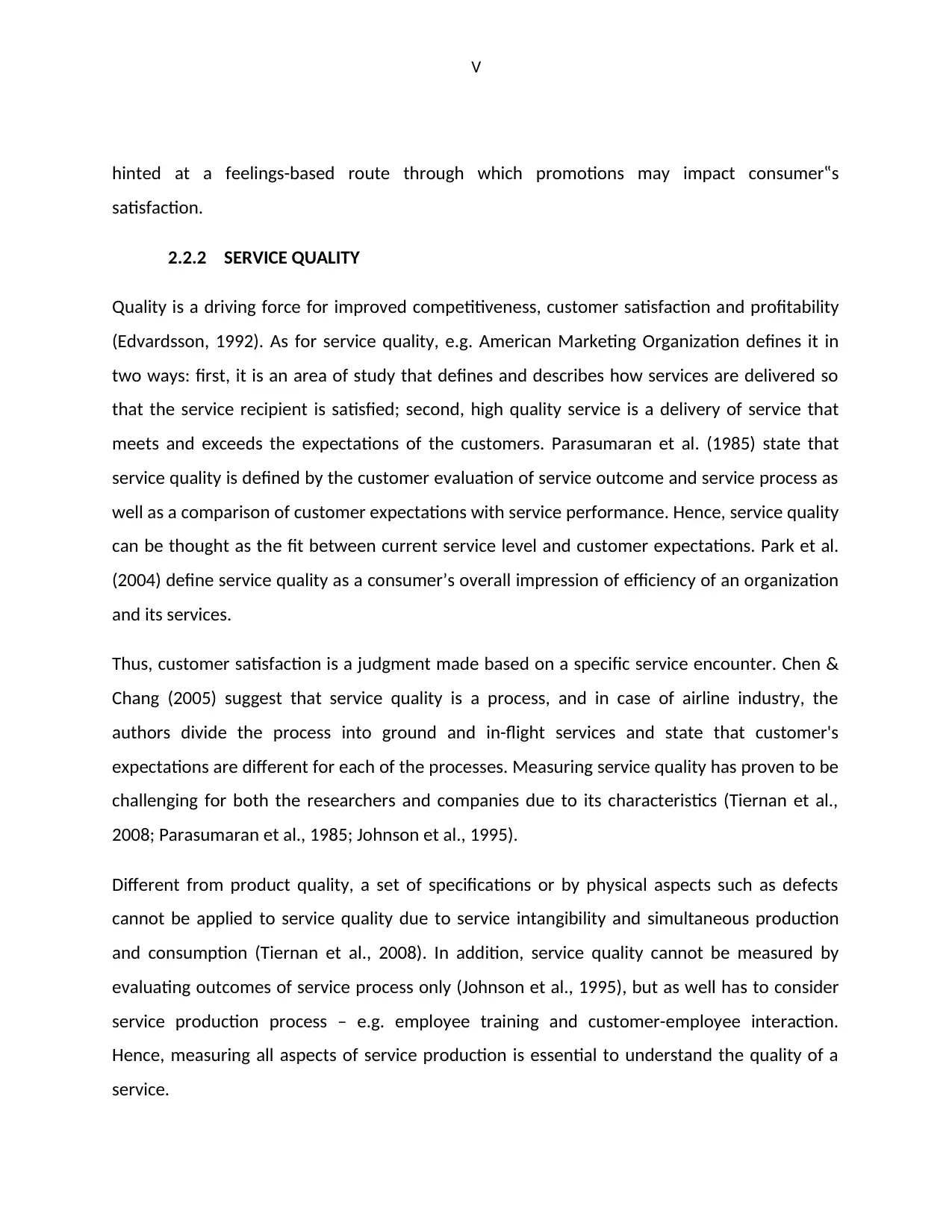
V
hinted at a feelings-based route through which promotions may impact consumer‟s
satisfaction.
2.2.2 SERVICE QUALITY
Quality is a driving force for improved competitiveness, customer satisfaction and profitability
(Edvardsson, 1992). As for service quality, e.g. American Marketing Organization defines it in
two ways: first, it is an area of study that defines and describes how services are delivered so
that the service recipient is satisfied; second, high quality service is a delivery of service that
meets and exceeds the expectations of the customers. Parasumaran et al. (1985) state that
service quality is defined by the customer evaluation of service outcome and service process as
well as a comparison of customer expectations with service performance. Hence, service quality
can be thought as the fit between current service level and customer expectations. Park et al.
(2004) define service quality as a consumer’s overall impression of efficiency of an organization
and its services.
Thus, customer satisfaction is a judgment made based on a specific service encounter. Chen &
Chang (2005) suggest that service quality is a process, and in case of airline industry, the
authors divide the process into ground and in-flight services and state that customer's
expectations are different for each of the processes. Measuring service quality has proven to be
challenging for both the researchers and companies due to its characteristics (Tiernan et al.,
2008; Parasumaran et al., 1985; Johnson et al., 1995).
Different from product quality, a set of specifications or by physical aspects such as defects
cannot be applied to service quality due to service intangibility and simultaneous production
and consumption (Tiernan et al., 2008). In addition, service quality cannot be measured by
evaluating outcomes of service process only (Johnson et al., 1995), but as well has to consider
service production process – e.g. employee training and customer-employee interaction.
Hence, measuring all aspects of service production is essential to understand the quality of a
service.
hinted at a feelings-based route through which promotions may impact consumer‟s
satisfaction.
2.2.2 SERVICE QUALITY
Quality is a driving force for improved competitiveness, customer satisfaction and profitability
(Edvardsson, 1992). As for service quality, e.g. American Marketing Organization defines it in
two ways: first, it is an area of study that defines and describes how services are delivered so
that the service recipient is satisfied; second, high quality service is a delivery of service that
meets and exceeds the expectations of the customers. Parasumaran et al. (1985) state that
service quality is defined by the customer evaluation of service outcome and service process as
well as a comparison of customer expectations with service performance. Hence, service quality
can be thought as the fit between current service level and customer expectations. Park et al.
(2004) define service quality as a consumer’s overall impression of efficiency of an organization
and its services.
Thus, customer satisfaction is a judgment made based on a specific service encounter. Chen &
Chang (2005) suggest that service quality is a process, and in case of airline industry, the
authors divide the process into ground and in-flight services and state that customer's
expectations are different for each of the processes. Measuring service quality has proven to be
challenging for both the researchers and companies due to its characteristics (Tiernan et al.,
2008; Parasumaran et al., 1985; Johnson et al., 1995).
Different from product quality, a set of specifications or by physical aspects such as defects
cannot be applied to service quality due to service intangibility and simultaneous production
and consumption (Tiernan et al., 2008). In addition, service quality cannot be measured by
evaluating outcomes of service process only (Johnson et al., 1995), but as well has to consider
service production process – e.g. employee training and customer-employee interaction.
Hence, measuring all aspects of service production is essential to understand the quality of a
service.
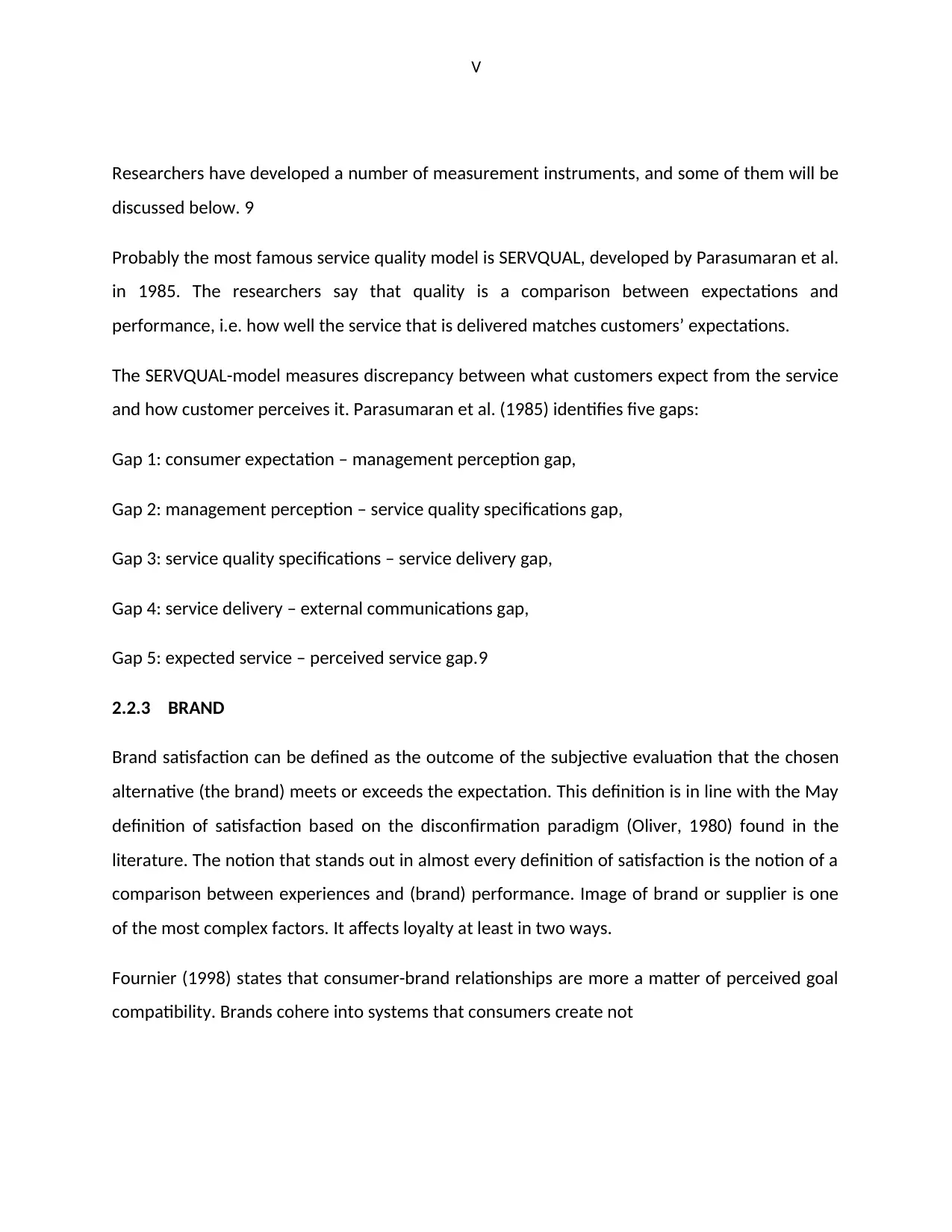
V
Researchers have developed a number of measurement instruments, and some of them will be
discussed below. 9
Probably the most famous service quality model is SERVQUAL, developed by Parasumaran et al.
in 1985. The researchers say that quality is a comparison between expectations and
performance, i.e. how well the service that is delivered matches customers’ expectations.
The SERVQUAL-model measures discrepancy between what customers expect from the service
and how customer perceives it. Parasumaran et al. (1985) identifies five gaps:
Gap 1: consumer expectation – management perception gap,
Gap 2: management perception – service quality specifications gap,
Gap 3: service quality specifications – service delivery gap,
Gap 4: service delivery – external communications gap,
Gap 5: expected service – perceived service gap.9
2.2.3 BRAND
Brand satisfaction can be defined as the outcome of the subjective evaluation that the chosen
alternative (the brand) meets or exceeds the expectation. This definition is in line with the May
definition of satisfaction based on the disconfirmation paradigm (Oliver, 1980) found in the
literature. The notion that stands out in almost every definition of satisfaction is the notion of a
comparison between experiences and (brand) performance. Image of brand or supplier is one
of the most complex factors. It affects loyalty at least in two ways.
Fournier (1998) states that consumer-brand relationships are more a matter of perceived goal
compatibility. Brands cohere into systems that consumers create not
Researchers have developed a number of measurement instruments, and some of them will be
discussed below. 9
Probably the most famous service quality model is SERVQUAL, developed by Parasumaran et al.
in 1985. The researchers say that quality is a comparison between expectations and
performance, i.e. how well the service that is delivered matches customers’ expectations.
The SERVQUAL-model measures discrepancy between what customers expect from the service
and how customer perceives it. Parasumaran et al. (1985) identifies five gaps:
Gap 1: consumer expectation – management perception gap,
Gap 2: management perception – service quality specifications gap,
Gap 3: service quality specifications – service delivery gap,
Gap 4: service delivery – external communications gap,
Gap 5: expected service – perceived service gap.9
2.2.3 BRAND
Brand satisfaction can be defined as the outcome of the subjective evaluation that the chosen
alternative (the brand) meets or exceeds the expectation. This definition is in line with the May
definition of satisfaction based on the disconfirmation paradigm (Oliver, 1980) found in the
literature. The notion that stands out in almost every definition of satisfaction is the notion of a
comparison between experiences and (brand) performance. Image of brand or supplier is one
of the most complex factors. It affects loyalty at least in two ways.
Fournier (1998) states that consumer-brand relationships are more a matter of perceived goal
compatibility. Brands cohere into systems that consumers create not
⊘ This is a preview!⊘
Do you want full access?
Subscribe today to unlock all pages.

Trusted by 1+ million students worldwide
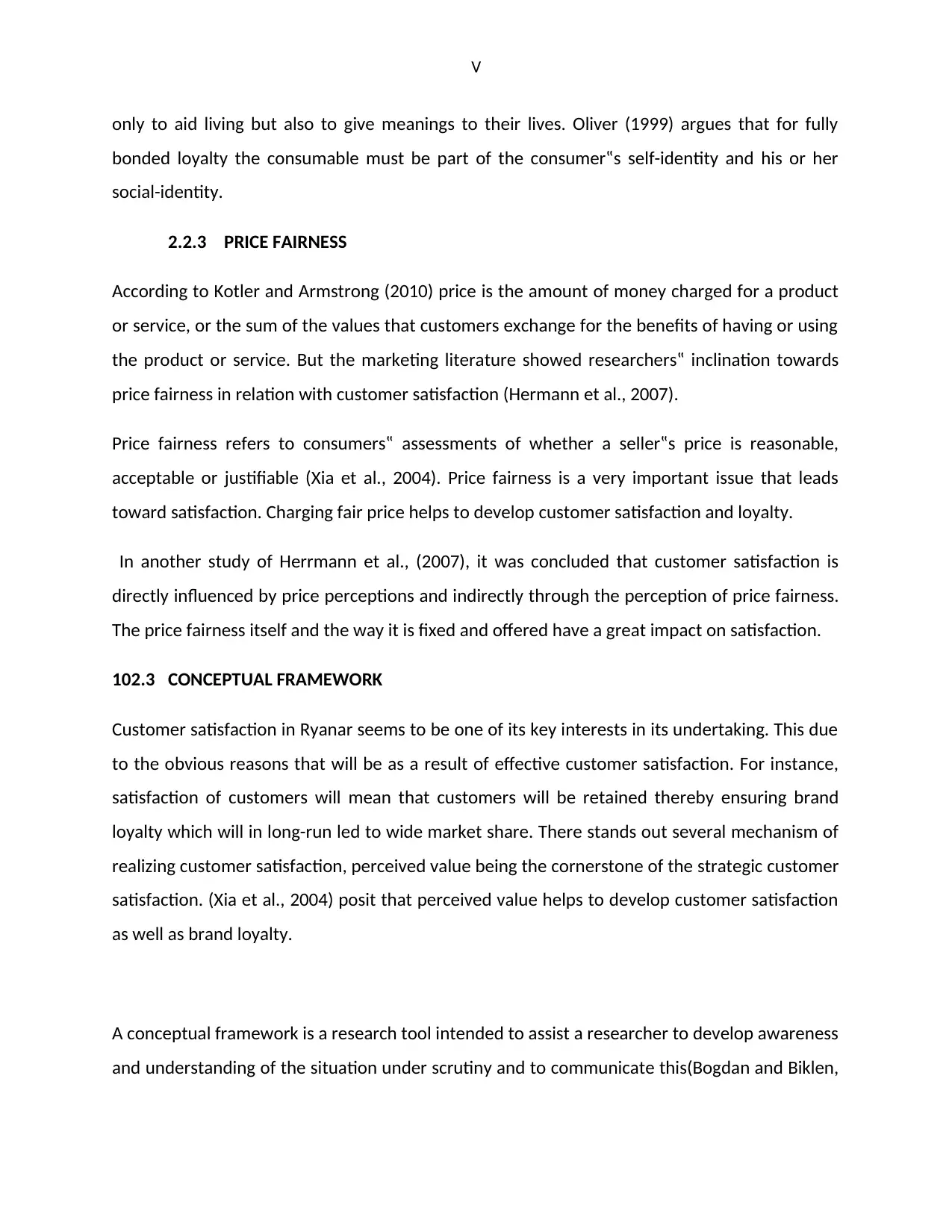
V
only to aid living but also to give meanings to their lives. Oliver (1999) argues that for fully
bonded loyalty the consumable must be part of the consumer‟s self-identity and his or her
social-identity.
2.2.3 PRICE FAIRNESS
According to Kotler and Armstrong (2010) price is the amount of money charged for a product
or service, or the sum of the values that customers exchange for the benefits of having or using
the product or service. But the marketing literature showed researchers‟ inclination towards
price fairness in relation with customer satisfaction (Hermann et al., 2007).
Price fairness refers to consumers‟ assessments of whether a seller‟s price is reasonable,
acceptable or justifiable (Xia et al., 2004). Price fairness is a very important issue that leads
toward satisfaction. Charging fair price helps to develop customer satisfaction and loyalty.
In another study of Herrmann et al., (2007), it was concluded that customer satisfaction is
directly influenced by price perceptions and indirectly through the perception of price fairness.
The price fairness itself and the way it is fixed and offered have a great impact on satisfaction.
102.3 CONCEPTUAL FRAMEWORK
Customer satisfaction in Ryanar seems to be one of its key interests in its undertaking. This due
to the obvious reasons that will be as a result of effective customer satisfaction. For instance,
satisfaction of customers will mean that customers will be retained thereby ensuring brand
loyalty which will in long-run led to wide market share. There stands out several mechanism of
realizing customer satisfaction, perceived value being the cornerstone of the strategic customer
satisfaction. (Xia et al., 2004) posit that perceived value helps to develop customer satisfaction
as well as brand loyalty.
A conceptual framework is a research tool intended to assist a researcher to develop awareness
and understanding of the situation under scrutiny and to communicate this(Bogdan and Biklen,
only to aid living but also to give meanings to their lives. Oliver (1999) argues that for fully
bonded loyalty the consumable must be part of the consumer‟s self-identity and his or her
social-identity.
2.2.3 PRICE FAIRNESS
According to Kotler and Armstrong (2010) price is the amount of money charged for a product
or service, or the sum of the values that customers exchange for the benefits of having or using
the product or service. But the marketing literature showed researchers‟ inclination towards
price fairness in relation with customer satisfaction (Hermann et al., 2007).
Price fairness refers to consumers‟ assessments of whether a seller‟s price is reasonable,
acceptable or justifiable (Xia et al., 2004). Price fairness is a very important issue that leads
toward satisfaction. Charging fair price helps to develop customer satisfaction and loyalty.
In another study of Herrmann et al., (2007), it was concluded that customer satisfaction is
directly influenced by price perceptions and indirectly through the perception of price fairness.
The price fairness itself and the way it is fixed and offered have a great impact on satisfaction.
102.3 CONCEPTUAL FRAMEWORK
Customer satisfaction in Ryanar seems to be one of its key interests in its undertaking. This due
to the obvious reasons that will be as a result of effective customer satisfaction. For instance,
satisfaction of customers will mean that customers will be retained thereby ensuring brand
loyalty which will in long-run led to wide market share. There stands out several mechanism of
realizing customer satisfaction, perceived value being the cornerstone of the strategic customer
satisfaction. (Xia et al., 2004) posit that perceived value helps to develop customer satisfaction
as well as brand loyalty.
A conceptual framework is a research tool intended to assist a researcher to develop awareness
and understanding of the situation under scrutiny and to communicate this(Bogdan and Biklen,
Paraphrase This Document
Need a fresh take? Get an instant paraphrase of this document with our AI Paraphraser
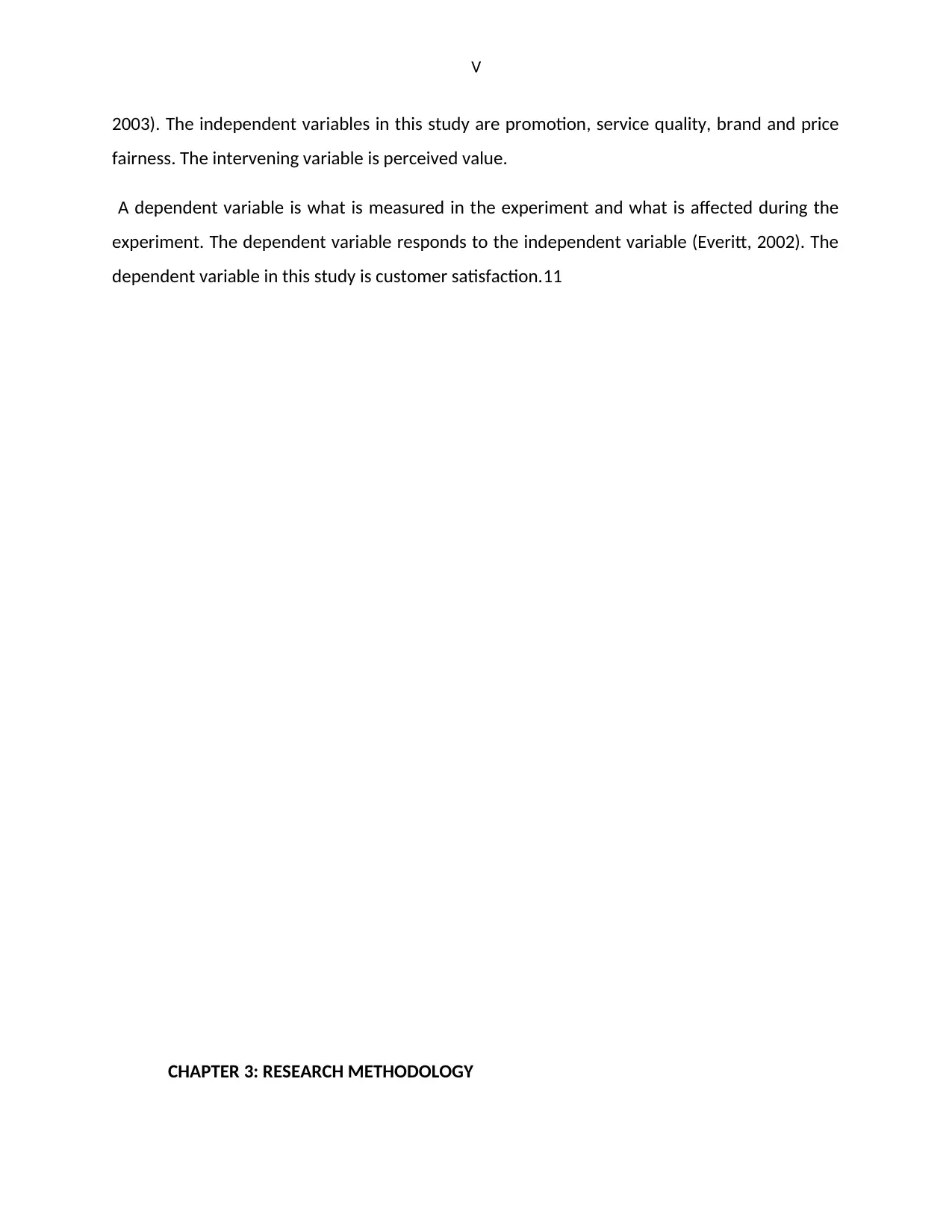
V
2003). The independent variables in this study are promotion, service quality, brand and price
fairness. The intervening variable is perceived value.
A dependent variable is what is measured in the experiment and what is affected during the
experiment. The dependent variable responds to the independent variable (Everitt, 2002). The
dependent variable in this study is customer satisfaction.11
CHAPTER 3: RESEARCH METHODOLOGY
2003). The independent variables in this study are promotion, service quality, brand and price
fairness. The intervening variable is perceived value.
A dependent variable is what is measured in the experiment and what is affected during the
experiment. The dependent variable responds to the independent variable (Everitt, 2002). The
dependent variable in this study is customer satisfaction.11
CHAPTER 3: RESEARCH METHODOLOGY
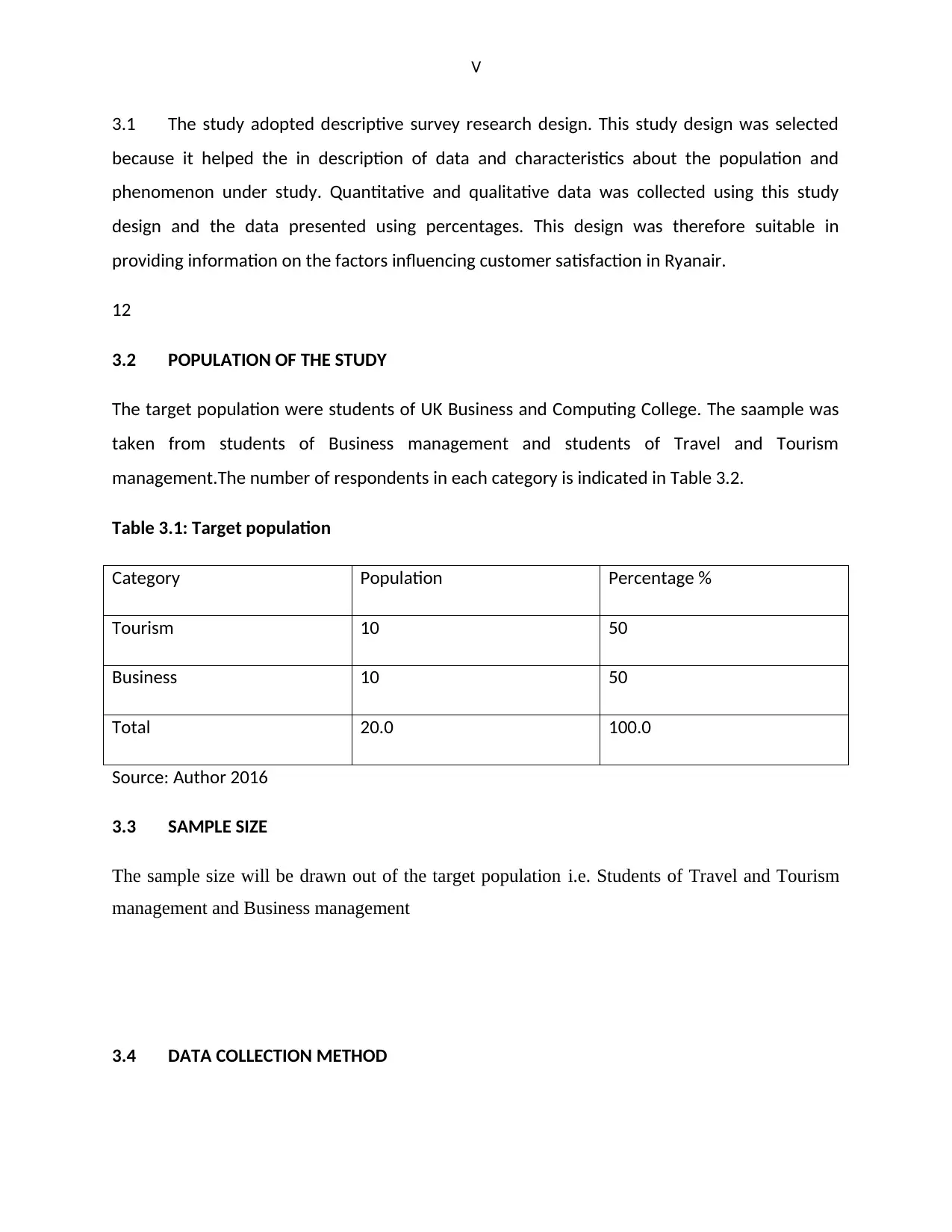
V
3.1 The study adopted descriptive survey research design. This study design was selected
because it helped the in description of data and characteristics about the population and
phenomenon under study. Quantitative and qualitative data was collected using this study
design and the data presented using percentages. This design was therefore suitable in
providing information on the factors influencing customer satisfaction in Ryanair.
12
3.2 POPULATION OF THE STUDY
The target population were students of UK Business and Computing College. The saample was
taken from students of Business management and students of Travel and Tourism
management.The number of respondents in each category is indicated in Table 3.2.
Table 3.1: Target population
Category Population Percentage %
Tourism 10 50
Business 10 50
Total 20.0 100.0
Source: Author 2016
3.3 SAMPLE SIZE
The sample size will be drawn out of the target population i.e. Students of Travel and Tourism
management and Business management
3.4 DATA COLLECTION METHOD
3.1 The study adopted descriptive survey research design. This study design was selected
because it helped the in description of data and characteristics about the population and
phenomenon under study. Quantitative and qualitative data was collected using this study
design and the data presented using percentages. This design was therefore suitable in
providing information on the factors influencing customer satisfaction in Ryanair.
12
3.2 POPULATION OF THE STUDY
The target population were students of UK Business and Computing College. The saample was
taken from students of Business management and students of Travel and Tourism
management.The number of respondents in each category is indicated in Table 3.2.
Table 3.1: Target population
Category Population Percentage %
Tourism 10 50
Business 10 50
Total 20.0 100.0
Source: Author 2016
3.3 SAMPLE SIZE
The sample size will be drawn out of the target population i.e. Students of Travel and Tourism
management and Business management
3.4 DATA COLLECTION METHOD
⊘ This is a preview!⊘
Do you want full access?
Subscribe today to unlock all pages.

Trusted by 1+ million students worldwide
1 out of 32
Related Documents
Your All-in-One AI-Powered Toolkit for Academic Success.
+13062052269
info@desklib.com
Available 24*7 on WhatsApp / Email
![[object Object]](/_next/static/media/star-bottom.7253800d.svg)
Unlock your academic potential
Copyright © 2020–2025 A2Z Services. All Rights Reserved. Developed and managed by ZUCOL.





